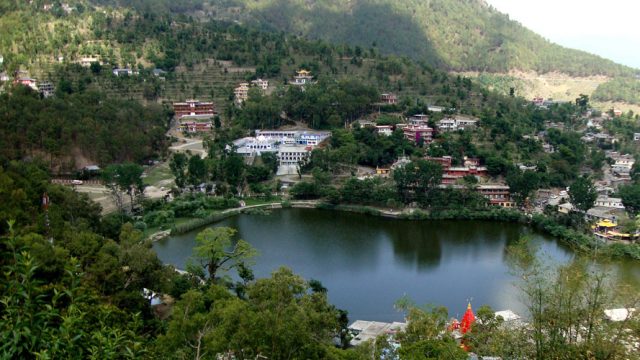Rewalsar’s lake may just have been given the go-by had it not been for love. The legend involves no less a figure than Padmasambhava, the tantrik teacher from Swat who introduced Mahayana Buddhism to Tibet, and the Princess of Sahor (Mandi). The king tried to thwart their love by condemning them to die in a fire. The fire raged for seven days and when the smoke finally cleared, a lake was in place with a huge lotus – Rewalsar.
The lake once had seven floating reed islands that Buddhists considered a symbol of Padmasambhava, called Guru Rinpoche by Tibetans. Today, however, only a small bit survives, dressed up in ribbons.
Rewalsar has been a pilgrimage centre since the 14th century, and the town has paid the price. There are buildings all around the lake. The saving grace is the sight of monks and families around the lake, swinging prayer wheels and thumbing beads.

THINGS TO SEE AND DO
Rewalsar is described by Himachal Pradesh Tourism as a ‘confluence of religions’, and indeed is home to Buddhist, Sikh and Hindu shrines. Apart from visiting the many places of worship, you can take a stroll around the lake. From Rewalsar you can trek to Sarkidhar (7 km) where Padmasambhava is said to have meditated. Another 2 km on lies the Ugartara Temple, also known as Nano Devo Temple.

Temples and Monasteries
Of the temples around the lake, Tso-Pema Ogyen Heru-kai Nyingmapa Gompa is the oldest, tracing its foundation to the 9th century CE. You can participate in religious ceremonies, including the mesmerising ‘lighting of lamps’ ritual.
Bhutanese Monasteries
The Jigar Monastery, behind Nyingmapa is run by Bhutanese Buddhists. The monastery was built only in the 1980s but includes unusual representations of the Buddha, including one with a trishul. The third Buddhist temple, Drikung Kagyud Gompa, belongs to the Nyingma school, the oldest school of Tibetan Buddhism, whose greatest teacher was Padmasambhava.
Hindu Temples
There are three temples here dedicated to Rishi Lomas, Shiva and Krishna. It is believed that like Padmasambhava, Rishi Lomas did penance at Rewalsar Lake, praying to Lord Shiva and attaining nirvana.
Guru Gobind Singh Gurudwara
Rewalsar is important to the Sikh faith too. The Guru Gobind Singh Gurudwara was built in 1930 by Raja Joginder Singh to commemorate the Tenth Guru’s visit to Rewalsar in 1738, when he came here to rally local rulers against Mughal rule.
Fairs
Rewalsar shrugs off its calm in February-March with the Sisu Fair, the Buddhist equivalent of the Kumbh Mela. During Baisakhi, pilgrims come here to light lamps and offer prayers at the Lomas Rishi Temple.
WHERE TO STAY AND EAT
HPTDC’s Tourist Inn (Tel: 01905-240252; Tariff: ₹500-1,800) overlooks the lake. Hotel Lotus Lake (Tel: 240239; Tariff: ₹500-1,000) is airy. Tso-Pema Ogyen Heru-kai Nyingmapa Gompa has a hostel (Tel: 240226; Tariff: ₹100-500) on its premises, and caters to pilgrims.
Try Gomush Tibetan Restaurant, next to the gompa, for the best momos and fried mutton noodles.
For better options, consider a hotel in nearby Mandi. Rajmahal Palace Hotel (Tel: 01905-222401; Tariff: ₹900-4,800) is near the District Courts. Even better is Munish Resorts (Tel: 235035, 236336; Tariff: ₹1,000-6,000) and Visco Resorts (Tel: 224640; Tariff: ₹1,800-6,000) on NH21.
When to go In autumn from mid-Sept to mid-Nov. Location Location At 4,100 ft, 21 km south-west of the district HQ Mandi, in south-central Himachal Air Nearest airport: Bhuntar Rail Nearest rail: Chandigarh




